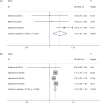Prediabetes and structural brain abnormalities: Evidence from observational studies
- PMID: 31856401
- PMCID: PMC7685098
- DOI: 10.1002/dmrr.3261
Prediabetes and structural brain abnormalities: Evidence from observational studies
Abstract
Type 2 diabetes mellitus has been linked to structural brain abnormalities, but evidence of the association among prediabetes and structural brain abnormalities has not been systematically evaluated. Comprehensive searching strategies and relevant studies were systematically retrieved from PubMed, Embase, Medline and web of science. Twelve articles were included overall. Stratified analyses and regression analyses were performed. A total of 104 468 individuals were included. The risk of infarct was associated with continuous glycosylated haemoglobin (HbA1c ) [adjusted odds ratio (OR) 1.19 (95% confidence interval [CI]: 1.05-1.34)], or prediabetes [adjusted OR 1.13 (95% CI: 1.00-1.27)]. The corresponding ORs associated with white matter hyperintensities were 1.08 (95%CI: 1.04-1.13) for prediabetes, and 1.10 (95%CI: 1.08-1.12) for HbA1c . The association was significant between the decreased risk of brain volume with continuous HbA1c (the combined OR 0.92, 95% CI: 0.87-0.98). Grey matter volume and white matter volume were inversely associated with prediabetes [weighted mean deviation (WMD), -9.65 (95%CI: -15.25 to -4.04) vs WMD, -9.25 (95%CI: -15.03 to -3.47)]. There were no significant association among cerebral microbleeds, hippocampal volume, continuous total brain volume, and prediabetes. Our findings demonstrated that (a) both prediabetes and continuous HbA1c were significantly associated with increasing risk of infarct or white matter hyperintensities; (b) continuous HbA1c was associated with a decreased risk of brain volume; (c) prediabetes was inversely associated with grey matter volume and white matter volume. To confirm these findings, further studies on early diabetes onset and structural brain abnormalities are needed.
Keywords: glycosylated haemoglobin; meta-analysis; prediabetes; structural brain abnormalities.
© 2019 John Wiley & Sons Ltd.
Conflict of interest statement
The authors declare no potential conflict of interest.
Figures





References
-
- Ott A, Stolk R, Van Harskamp F, et al. Diabetes mellitus and the risk of dementia: the Rotterdam study. Neurology. 1999;53(9):1937‐1937, 1942. - PubMed
-
- Wang L, Leonards CO, Sterzer P, et al. White matter lesions and depression: a systematic review and meta‐analysis. J Psychiatr Res. 2014;56:56‐64. - PubMed
-
- Van Harten B, Oosterman J, Muslimovic D, et al. Cognitive impairment and MRI correlates in the elderly patients with type 2 diabetes mellitus. Age Ageing. 2007;36(2):164‐170. - PubMed
-
- Kerti L, Witte AV, Winkler A, Grittner U, Rujescu D, Floel A. Higher glucose levels associated with lower memory and reduced hippocampal microstructure. Neurology. 2013;81(20):1746‐1752. - PubMed
Publication types
MeSH terms
Grants and funding
LinkOut - more resources
Full Text Sources
Medical
Miscellaneous

